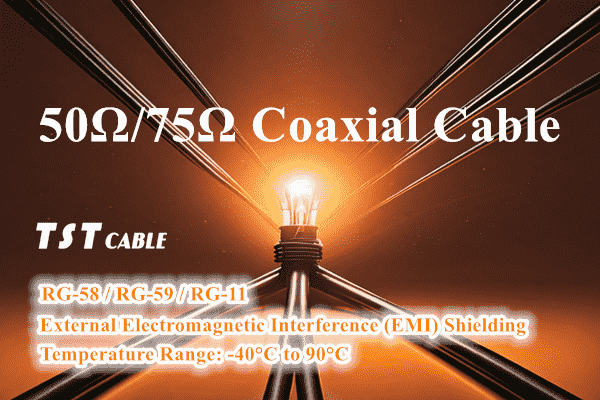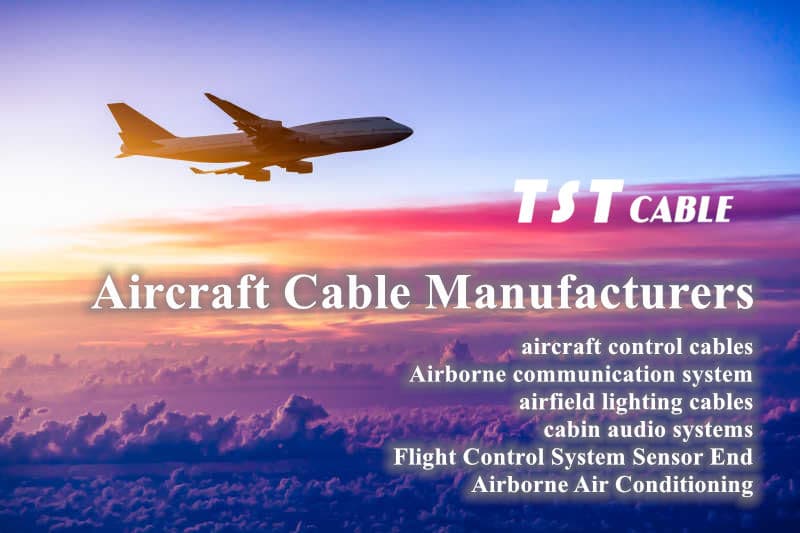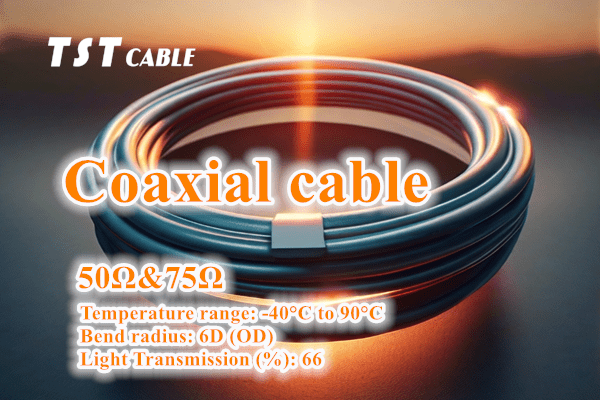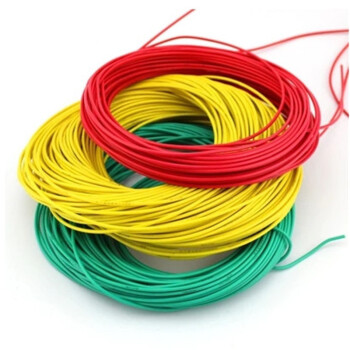
Coaxial cable refers to a cable with two concentric conductors, and the conductor and shielding layer share the same axis. The most common coaxial cable consists of a copper wire conductor isolated by insulating material, and outside the inner insulating material is another layer of ring conductor and its insulator, and then the entire cable is wrapped by a sheath of polyvinyl chloride or Teflon material.
Classification of coaxial cables:
Coaxial cables can be divided into two basic types, baseband coaxial cables and broadband coaxial cables. Currently, baseband is a commonly used cable, and its shielding wire is made of copper mesh with a characteristic impedance of 50 (such as RG-8, RG-58, etc.); the shielding layer of broadband coaxial cables is usually stamped with aluminum, with a characteristic impedance of 75 (such as RG-59, etc.).
Coaxial cables can be divided into thick coaxial cables and thin coaxial cables according to their diameter. Thick cables are suitable for relatively large local networks. They have long standard distances and high reliability. Since the cable does not need to be cut during installation, the computer’s access position can be flexibly adjusted as needed. However, thick cable networks must be installed with transceiver cables, which are difficult to install, so the overall cost is high. On the contrary, thin cables are relatively simple to install and have low costs, but since the cable must be cut during the installation process, basic network connectors (BNC) must be installed at both ends and then connected to the two ends of the T-type connector, so when there are many connectors, it is easy to produce bad hidden dangers, which is one of the most common faults in the currently running Ethernet.
Both thick and thin cables are bus topology structures, that is, multiple machines are connected to one cable. This topology is suitable for machine-intensive environments, but when a contact fails, the fault will affect all machines on the entire cable in series. Fault diagnosis and repair are very troublesome, so they will gradually be replaced by unshielded twisted pair or optical cables.
Working principle of coaxial cable:
Coaxial cable is divided into four layers from inside to outside: central copper wire (single-strand solid wire or multi-strand twisted wire), plastic insulator, mesh conductive layer and wire sheath. The central copper wire and the mesh conductive layer form a current loop. The central copper wire and the mesh conductive layer are named because they are coaxial.
Coaxial cables conduct alternating current rather than direct current, which means that the direction of the current reverses several times per second.
If ordinary wires are used to transmit high-frequency currents, such wires will be equivalent to antennas that transmit radio waves outward. This effect consumes the power of the signal and reduces the strength of the received signal.
Coaxial cables are designed to solve this problem. The radio waves emitted by the central wire are isolated by the mesh conductive layer, which can control the emitted radio waves by grounding.
There is also a problem with coaxial cables. If a certain section of the cable is squeezed or twisted, the distance between the central wire and the mesh conductive layer is not consistent, which will cause the internal radio waves to be reflected back to the signal source. This effect reduces the receivable signal power. To overcome this problem, a layer of plastic insulator is added between the central wire and the mesh conductive layer to ensure that the distance between them is consistent. This also makes this cable relatively rigid and not easy to bend.
Advantages and disadvantages of coaxial cable:
The advantage of coaxial cable is that it can support high-bandwidth communication on relatively long lines without repeaters, but its disadvantages are also obvious: first, it is large in size. The diameter of the thin cable is 3/8 inches thick, which takes up a lot of space in the cable duct; second, it cannot withstand entanglement, pressure and severe bending, which will damage the cable structure and prevent signal transmission; finally, it is expensive, and all these disadvantages can be overcome by twisted pair cables. Therefore, in the current LAN environment, it has basically been replaced by the Ethernet physical layer specification based on twisted pair cables.
Parameter indicators of coaxial cable:
Main electrical parameters
(1) Characteristic impedance of coaxial cable The average characteristic impedance of coaxial cable is 50±2Ω. The periodic change of impedance along a single coaxial cable is a sine wave with a central average value of ±3Ω. Its length is less than 2 meters.
(2) The attenuation of coaxial cable generally refers to the attenuation value of a 500-meter cable segment. When measured with a 10MHz sine wave, its value does not exceed 8.5db (17db/km); and when measured with a 5MHz sine wave, its value does not exceed 6.0db (12db/km).
(3) The propagation speed of coaxial cable requires a minimum propagation speed of 0.77C (C is the speed of light).
(4) The sum of the resistance of the center conductor of the coaxial cable and the resistance of the shielding layer does not exceed 10 milliohms/meter (measured at 20°C).
Physical parameters:
Coaxial cable consists of a center conductor, an insulating material layer, a shielding layer composed of a mesh fabric, and an outer insulating material layer.
Coaxial cable is flexible enough to support a bending radius of 254mm (10 inches). The center conductor is a solid copper wire with a diameter of 2.17mm±0.013mm. The insulating material must meet the electrical parameters of the coaxial cable. The shielding layer is composed of a metal strip or sheet that meets the transmission impedance and ECM specifications. The inner diameter of the shielding layer is 6.15mm and the outer diameter is 8.28mm. The external isolation material is generally polyvinyl chloride (such as PVC) or similar materials.
Main parameters of the test:
(1) Open circuit of the conductor or shielding layer.
(2) Short circuit between the conductor and the shielding layer.
(3) Grounding of the conductor.
(4) Short circuit between the shielding joints.
- Introduction to ordinary cables
Cable (electric cable; power cable): usually composed of several or several groups of wires.
Definition 1: A wire made of one or more mutually insulated conductors and an outer insulating protective layer to transmit electricity or information from one place to another.
Definition 2: Usually a rope-like cable made of several or several groups of wires (at least two in each group). Each group of wires is insulated from each other and is often twisted around a center. The entire outside is covered with a highly insulating covering. The cable has the characteristics of internal power supply and external insulation.
Cable classification:
Cables include power cables, control cables, compensation cables, shielded cables, high-temperature cables, computer cables, signal cables, coaxial cables, fire-resistant cables, marine cables, mining cables, aluminum alloy cables, etc. They are all composed of single-strand or multi-strand wires and insulation layers, and are used to connect circuits, electrical appliances, etc.
Cables can be divided into DC cables and AC cables according to the system of photovoltaic power stations. According to different uses and usage environments, they are classified as follows:
- DC cables
(1) Series cables between components.
(2) Parallel cables between strings and between strings and DC distribution boxes (combiner boxes).
(3) Cables between DC distribution boxes and inverters.
All of the above cables are DC cables, which are mostly laid outdoors and need to be moisture-proof, sun-proof, cold-resistant, heat-resistant, and UV-resistant. In some special environments, they also need to be resistant to chemicals such as acids and alkalis.
- AC cables
(1) Connection cables from inverters to step-up transformers.
(2) Connection cables from step-up transformers to distribution devices.
(3) Connection cables from distribution devices to power grids or users.
This part of the cable is an AC load cable, which is mostly laid in indoor environments and can be selected according to the general power cable selection requirements.
Cable application:
- Power system
The wire and cable products used in the power system mainly include overhead bare wires, busbars, power cables (plastic cables, oil-paper power cables (basically replaced by plastic power cables), rubber-sheathed cables, overhead insulated cables), branch cables (replacing some busbars), electromagnetic wires, and electrical equipment wires and cables for power equipment. - Information transmission
The wires and cables used in information transmission systems mainly include local telephone cables, TV cables, electronic cables, radio frequency cables, optical fiber cables, data cables, electromagnetic wires, power communications or other composite cables. - Instrument system
Almost all products except overhead bare wires are used in this part, but they are mainly power cables, electromagnetic wires, data cables, instrument cables, etc.
Installation method:
Coaxial cables are generally installed between devices. A connector is equipped at each user position to provide an interface for the user. The installation method of the interface is as follows:
(1) Thin cable: cut the thin cable, install BNC heads on both ends, and then connect them to the two ends of the T-type connector.
(2) Thick cable: thick cable is generally installed using a tap device similar to a splint. It uses the guide pin on the tap to penetrate the insulation layer of the cable and connect directly to the conductor. Terminals are installed at both ends of the cable to weaken the reflection of the signal.
- The difference between coaxial cable and ordinary cable
Coaxial cable refers to a cable with two concentric conductors, and the conductor and shielding layer share the same axis. It is often used to connect devices or in bus network topology. The central axis of the coaxial cable is a copper wire with a layer of insulating material. The outer side of this insulating material is wrapped by a hollow cylindrical mesh copper conductor, and the outermost layer is an insulating layer. Compared with twisted pair cables, coaxial cables have strong anti-interference ability, good shielding performance, stable data transmission, and low price. Moreover, it can be used without connecting to a hub or switch. Ordinary cables are usually rope-like cables twisted together by several or several groups of wires (at least two in each group). Each group of wires is insulated from each other and often twisted around a center, with a highly insulating covering on the outside. They are often installed in the air or underground or underwater for telecommunications or power transmission.
Coaxial cables are often used to connect devices to each other or in bus network topologies. The central axis of the coaxial cable is a copper conductor with an insulating material. Outside this insulating material is a hollow cylindrical mesh copper conductor, and the outermost layer is an insulating layer. Compared with twisted pair cables, coaxial cables have strong anti-interference ability, good shielding performance, stable data transmission, and low price, and they can be used without being connected to a hub or switch.
Ordinary cables are usually rope-like cables twisted together by several or several groups of wires, at least two in each group. Each group of wires is insulated from each other and often twisted around a center, with a highly insulating covering on the outside. Most of them are installed in the air or underground or underwater for telecommunications or power transmission.
In today’s highly interconnected world, every cable carries a vital mission – to ensure the accuracy and stability of signal transmission. Coaxial cable, with its excellent performance and reliability, has become the ideal choice for many high-end devices. TST CABLES coaxial cable uses the most advanced materials and processes, not only has excellent anti-electromagnetic interference ability, but also can maintain the purity of the signal in a complex environment. Whether it is precision communication in aerospace or critical data transmission in medical equipment, our coaxial cables can provide an unparalleled connection experience. We are well aware of the importance behind every connection, so we are committed to the perfect presentation of every detail.
If you have customized coaxial cables, UL cables, UL 758 Cable,Teflon wires, armored wires, industrial cables, power cables, control cables and other products, and need further technical support or cable solutions, you can always send an email to the professional cable engineer of TST cable manufacturer (email: lixiangchao@testeck.com, please state your country, your industry, and your needs in the email, we can also provide you with free samples)
Also available in:
English





